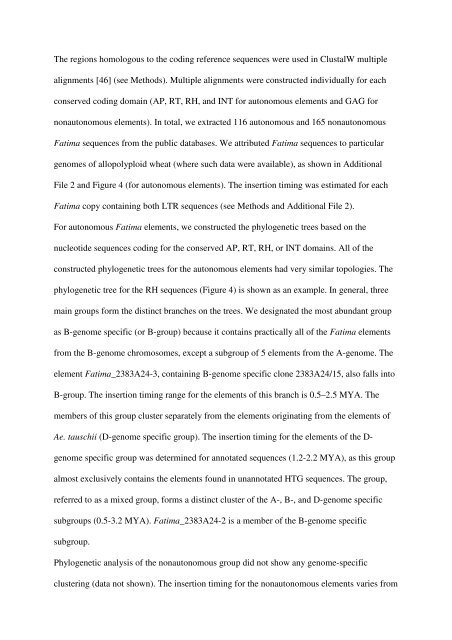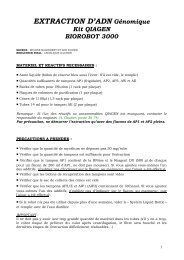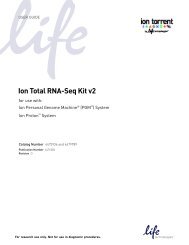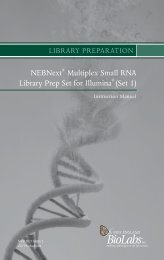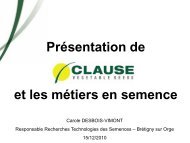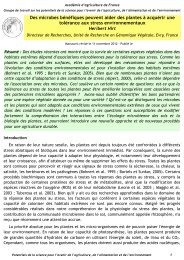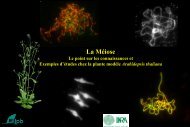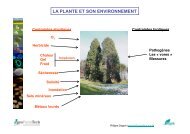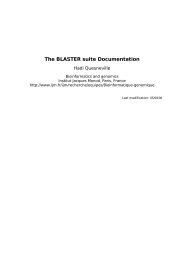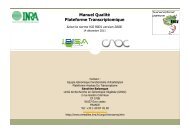The impact of Ty3-gypsy group LTR retrotransposons ... - URGV - Inra
The impact of Ty3-gypsy group LTR retrotransposons ... - URGV - Inra
The impact of Ty3-gypsy group LTR retrotransposons ... - URGV - Inra
Create successful ePaper yourself
Turn your PDF publications into a flip-book with our unique Google optimized e-Paper software.
<strong>The</strong> regions homologous to the coding reference sequences were used in ClustalW multiple<br />
alignments [46] (see Methods). Multiple alignments were constructed individually for each<br />
conserved coding domain (AP, RT, RH, and INT for autonomous elements and GAG for<br />
nonautonomous elements). In total, we extracted 116 autonomous and 165 nonautonomous<br />
Fatima sequences from the public databases. We attributed Fatima sequences to particular<br />
genomes <strong>of</strong> allopolyploid wheat (where such data were available), as shown in Additional<br />
File 2 and Figure 4 (for autonomous elements). <strong>The</strong> insertion timing was estimated for each<br />
Fatima copy containing both <strong>LTR</strong> sequences (see Methods and Additional File 2).<br />
For autonomous Fatima elements, we constructed the phylogenetic trees based on the<br />
nucleotide sequences coding for the conserved AP, RT, RH, or INT domains. All <strong>of</strong> the<br />
constructed phylogenetic trees for the autonomous elements had very similar topologies. <strong>The</strong><br />
phylogenetic tree for the RH sequences (Figure 4) is shown as an example. In general, three<br />
main <strong>group</strong>s form the distinct branches on the trees. We designated the most abundant <strong>group</strong><br />
as B-genome specific (or B-<strong>group</strong>) because it contains practically all <strong>of</strong> the Fatima elements<br />
from the B-genome chromosomes, except a sub<strong>group</strong> <strong>of</strong> 5 elements from the A-genome. <strong>The</strong><br />
element Fatima_2383A24-3, containing B-genome specific clone 2383A24/15, also falls into<br />
B-<strong>group</strong>. <strong>The</strong> insertion timing range for the elements <strong>of</strong> this branch is 0.5–2.5 MYA. <strong>The</strong><br />
members <strong>of</strong> this <strong>group</strong> cluster separately from the elements originating from the elements <strong>of</strong><br />
Ae. tauschii (D-genome specific <strong>group</strong>). <strong>The</strong> insertion timing for the elements <strong>of</strong> the D-<br />
genome specific <strong>group</strong> was determined for annotated sequences (1.2-2.2 MYA), as this <strong>group</strong><br />
almost exclusively contains the elements found in unannotated HTG sequences. <strong>The</strong> <strong>group</strong>,<br />
referred to as a mixed <strong>group</strong>, forms a distinct cluster <strong>of</strong> the A-, B-, and D-genome specific<br />
sub<strong>group</strong>s (0.5-3.2 MYA). Fatima_2383A24-2 is a member <strong>of</strong> the B-genome specific<br />
sub<strong>group</strong>.<br />
Phylogenetic analysis <strong>of</strong> the nonautonomous <strong>group</strong> did not show any genome-specific<br />
clustering (data not shown). <strong>The</strong> insertion timing for the nonautonomous elements varies from


